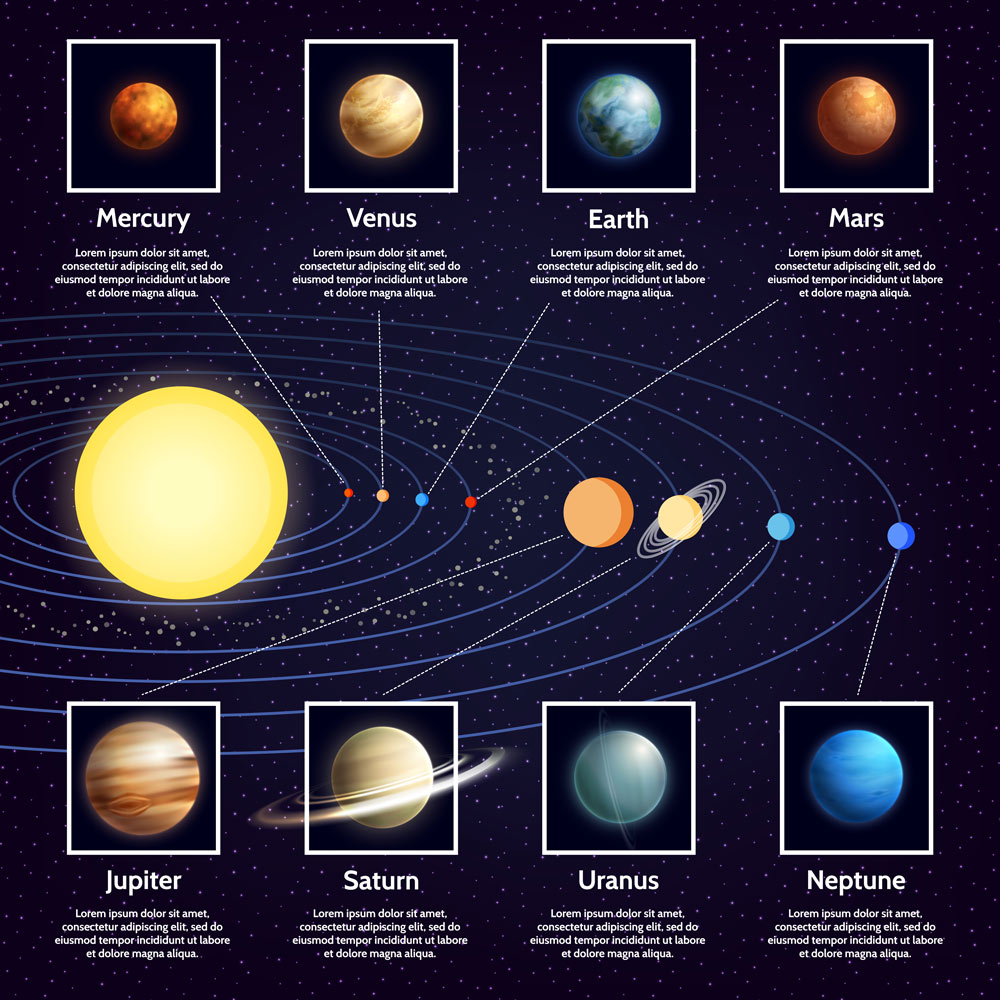Estimated reading time: 5 minutes
The atmospheric diversity of the planets
Our solar system is remarkably diverse. All 8 planets differ greatly in size, distance from the Sun, internal structure and atmospheric composition. Particularly striking is how different the atmospheres of the planets are, from the dense clouds of Venus to the rarefied gases of Jupiter. How did such “atmospheric diversity” in the Solar System come to be? What determines the composition of the gas shells of the planets? Let’s find out!
Earth is a planet with a unique atmosphere
Let’s start with the fact that the atmosphere of our native Earth is quite unusual for space. Its main components – nitrogen and oxygen – are found on other planets only in trace amounts. The Earth’s atmosphere is the result of the long evolution of the planet’s biosphere.

In ancient times, the Earth’s atmosphere consisted mainly of carbon dioxide, nitrogen, water vapour and a small amount of hydrogen. But the emergence of life changed it dramatically. Photosynthesising bacteria began to produce oxygen and plants absorbed carbon dioxide. As a result, the modern composition of the air is determined by the activities of living organisms.
Thus, the Earth’s atmosphere is unique and “created” by the life of the planet. This explains its sharp difference from the atmospheres of other planets, where there is no active biosphere.
Factors determining the composition of a planet’s atmosphere
Although the Earth’s atmosphere is unusual, the composition of the atmospheres of other planets is also very diverse. What determines the peculiarities of the gas shell of each world?
First of all, the chemical and mineral composition of the planet itself is of great importance. For example, the presence of carbon and sulfur compounds in the rocks determines the increased content of CO2 and sulfur gases in the atmosphere.
Also important is the size of the planet and its gravitational force. The more massive the planet, the denser its atmosphere and the more heavy elements like argon in it. On small planets, the lighter gases are lost to space.
The distance from the star also matters because it determines the temperature regime. The further away from the Sun a planet is, the more volatile gases like hydrogen and helium are in its atmosphere.
Finally, volcanic activity replenishes the atmosphere with gases from the interior, and the planet’s magnetic field protects the gases from being carried off into space.
Taking all these factors into account can explain the differences in the atmospheres of specific planets.
Why is the atmosphere of Venus so dense?
Venus’ atmosphere is dramatically different from Earth’s. It consists mainly of carbon dioxide and has a density 90 times higher than Earth’s atmosphere! Why did such a “heavy” atmosphere form on Venus?
Firstly, Venus is closer to the Sun than the Earth and receives much more heat. High temperatures (over 400°C) prevent condensation of water vapour and carbon dioxide, forcing them to accumulate in the atmosphere.
Second, Venus does not have a global carbon cycle like Earth’s. Volcanic eruptions constantly release CO2, which is not absorbed by the biosphere due to the lack of life.
Third, Venus’ powerful gravity (at 0.9 g) keeps heavy gases in the atmosphere. And the absence of a magnetic field allows the solar wind to “blow” hydrogen and helium into space.
Thus, Venus’ dense atmosphere is a consequence of the planet’s characteristics as the solar system’s “greenhouse hell”. On Earth, life has prevented CO2 from accumulating in such concentrations.
Why is the atmosphere of Mars rarefied?
In stark contrast, the atmosphere of Mars is extremely rarefied and consists of 95% carbon dioxide. The density of air is 190 times less than on Earth! What has led to such “air poverty” of Mars?
The main reason is the planet’s low mass and gravity. Because of this, the atmosphere of Mars can not hold light gases like nitrogen and oxygen – they “flew away” into space.
Also affects the weak magnetic field of Mars, which almost does not protect the atmosphere from the effects of solar wind. Because of this gases are intensively knocked out into space.
Finally, on Mars volcanic activity – the source of replenishment of the atmosphere with gases – has stopped. Therefore, the atmosphere of Mars is gradually “exhaled” into space.
Thus, the rarefaction of the Martian atmosphere is a consequence of the planet’s low mass and weakening geological activity. In the future, the atmosphere may disappear altogether if no measures are taken to retain it.
The mysterious atmospheres of gas giants
The atmospheres of the distant giant planets have a completely different composition. The atmosphere of Jupiter, for example, consists mainly of hydrogen and helium with an admixture of methane, water vapour and ammonia. Why is such a volatile mixture of gases held together by the gravity of a huge planet?
Firstly, Jupiter’s high mass and strong gravity allow it to hold light elements like hydrogen and helium that would “fly away” from smaller planets.
Second, the low temperatures of the distant planets favour condensation and the accumulation of volatile compounds like ammonia and methane.
Third, active internal dynamics constantly mix and supplement the atmosphere with gases from the interior.
Vector image from freepik.com


